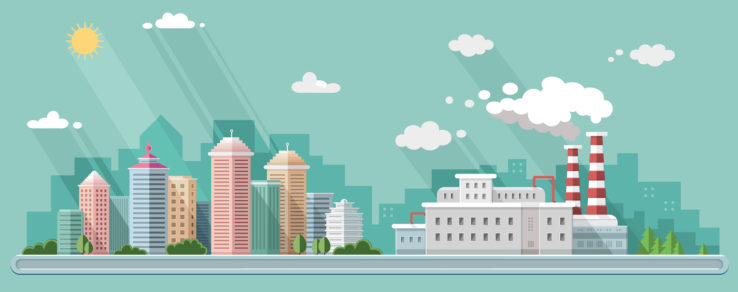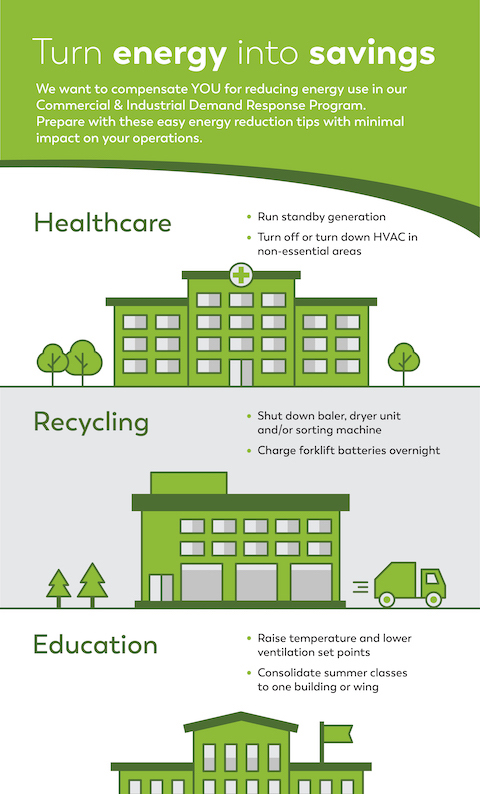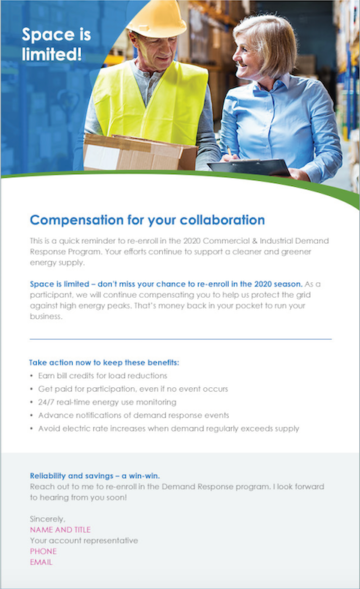Ensuring the reliability of your customers’ energy supply is one of the most important jobs for any utility — yet it’s often taken for granted by customers. By participating in commercial demand response programs, business customers will better understand the role they have to play and directly contribute to making the electric grid more stable.
How do energy utilities encourage business customers to participate in demand response? By sharing the benefits of these programs, addressing common objections and offering energy-saving education, utilities can enlist the participation of more businesses and ensure the success of demand response programs.
What Is Demand Response?
Demand response is an effort to manage the capacity of the electric grid during peak events, or times of extremely high power draw. If businesses and households demand more electricity than can be produced — say, during a hot August afternoon when the air conditioning is running full blast — it may lead to outages. Producing more electricity by constructing new power plants can be costly and take years of planning. Plus, it often it means adding more fossil fuel generation to the grid instead of renewable sources.
Demand response programs seek to minimize the impact of peak events and prevent the need for building more power plants. Commercial demand response programs pay business customers to reduce their power draw during peak events, ensuring the stability of the grid for other customers and ultimately reducing the cost of energy for everyone.
How Does Demand Response Impact Commercial and Industrial Customers?
Customers can look at demand response events in two ways: the (potentially temporary) inconvenience of participating and the (potentially detrimental) drawbacks of not participating.
Commercial and industrial customers who participate in demand response programs may be asked to reduce their power draw during peak events. This can lead to minor inconveniences like reducing HVAC use or major impacts like closing the business for part of the day. On the positive side, program participants receive financial incentives that may include cash payments or reduced rates — even if a response event is not needed. The amount of advanced notice varies by program.
Businesses that don’t participate would not receive these incentives, of course, but they still might suffer the negative effects. An unexpected outage during peak events could cause devastating business interruptions. Long term, without effective demand response programs, a utility might have to add more carbon-based generation to the grid and rely less on renewable sources — increasing the cost of energy for everyone.
How to Promote Demand Response Program Benefits
The importance of demand response programs to your utility is clear: Managing the load during peak events is critical to ensure the reliability and stability of the grid. But why are these programs important to businesses? When promoting demand response, the key is to focus on the benefits to your customers, not the benefits to your utility.
Commercial demand response programs benefit your customers in three significant ways:
- Financial incentives. Businesses get paid to participate in demand response programs and can benefit from upfront payments, rebates and/or lower energy rates.
- Operational planning. Program participants can prepare for demand response events and ensure smooth transitions. It’s much better than being caught off guard by unexpected outages.
- Green reputation. Businesses are partners with the utility in ensuring a cleaner and more stable energy supply for their community — which both employees and consumers appreciate.
Overcoming Common Hurdles to Demand Response Program Adoption
Despite these benefits, commercial and industrial customers may be wary of demand response programs. After all, reducing power draw could be a significant interruption to business operations. It’s important for energy utility marketers to acknowledge these objections and clearly address customers’ concerns.
Make it easy to participate. The thought of interrupting business operations or reducing power draw at a busy commercial facility may be overwhelming. Help customers participate, and demonstrate how easy it is, with clear guidelines and processes for demand response events.
Share testimonials. Who knows the benefits of demand response programs better than current participants? Look for success stories among your customers and capture video testimonials to share with businesses that are considering the program. Spoken in their own words, such videos are authentic and relatable to other business customers.
Segment messages by new/returning customers. If you require past participants to sign up for your demand response program each year, it’s important to remind them of the benefits even though they may already understand the program. New prospects, on the other hand, will require a more detailed explanation and may need repeated outreach.
Segment messages by industry. Reducing power draw during a demand response event will affect a healthcare facility much differently than, say, a factory or warehouse. It’s important to address each industry’s specific concerns with a segmented communication strategy and offer relevant participation advice for each type of facility.
Examples of Effective Commercial Demand Response Promotions
Commercial demand response programs may seem complex or intimidating to potential participants. It’s not enough to simply market the benefits of these programs with a typical campaign. Demand response promotions need to include a healthy dose of education to fully explain how the program works, the benefits of participation, and advice about compliance, including industry-specific efficiency information.
Questline Digital produced a comprehensive campaign for a major IOU in the Midwest to promote its demand response program. The campaign was a success, exceeding the utility’s participation goals and reaching customers in multiple channels with a variety of content formats:
- Website landing page with full program details and benefits
- Video testimonials from current participants
- Infographic with energy-saving advice
- Email campaigns to past participants and prospective new participants, including behavioral follow-up messages to both audiences
Business customers have an important role to play in maintaining the reliability of the electric grid. In addition to financial benefits, demand response participants can be proud of partnering with their utility to ensure a cleaner and more stable energy supply for the entire community.




